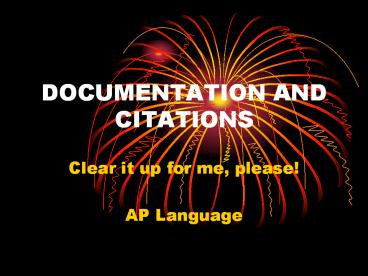DOCUMENTATION AND CITATIONS - PowerPoint PPT Presentation
1 / 12
Title:
DOCUMENTATION AND CITATIONS
Description:
DOCUMENTATION AND CITATIONS Clear it up for me, please! AP Language Why do we use citations? Give credit to author Avoid PLAGARISM! Show validity of sources How can I ... – PowerPoint PPT presentation
Number of Views:47
Avg rating:3.0/5.0
Title: DOCUMENTATION AND CITATIONS
1
DOCUMENTATION AND CITATIONS
- Clear it up for me, please!
- AP Language
2
Why do we use citations?
- Give credit to author
- Avoid PLAGARISM!
- Show validity of sources
Types of documentation
- MLA (Modern Language Assn.)
- APA (American Psychological Assn.)
- In-line
- Endnotes/footnotes
3
How can I use citations well?
- As evidence for some point you are making
- There are some advantages to brain damage, as
Kwiatkowski observes, you just dont care any
more (3) - To argue with an author from your position
- In contrast to what Mary Smith writes about the
negative effect of mothers who work full-time,
recent experiences have demonstrated no ill
effects on children can be documented (56). - Lets sources argue with each other
- Jane Johnson claims that men are animals(90), but
several other researchers have found that men are
angels (Lovelace 908 Principal 45 Shipley 56). - Shows acceptance of some parts and rejection of
others - It is true, as Stenzel says, the early bird
catches the worm (xi). However, she is dead
wrong to assume that everyone would want this to
happen.
4
MLA In-line Citations
- Also called in-text or parenthetical references
- Direct where you are quoting word-for-word lines
from another source - Indirect where you are paraphrasing ideas from
another source - This is where you must be careful to avoid
plagiarism.
5
Direct Citations
- Authors name in sentence
- Flora Davis reports that a chimp at the Yerkes
Primate Research Center has combined words into
new sentences that she was never taught (67). - Authors name in citation
- The chimp at the Yerkes Primate Research Center
has combined words into new sentences that she
was never taught (Davis 67). - More than one author
- The chimp at the Yerkes Primate Research Center
has combined words into new sentences that she
was never taught (Davis, Eloquent 67). - From the internet
- The chimp at the Yerkes Primate Research Center
has combined words into new sentences that she
was never taught (Yerkes).
6
Indirect Citations
- Paraphrasing ideas with authors name
- In Eloquent Animals, Flora Davis stated that
chimp at her center is able to create original
sentences from individual words it has been
taught (67). - Paraphrasing ideas without authors name
- The chimp is able to create original sentences
from individual words it has been taught (Davis
67).
7
How do I effectively integrate my quotes?
- Adverbial clauses (beginning with suddenly,
although, soon, too, etc.) - As William Smith observed last year in The New
York Times, the play was a rousing success (9). - Prepositional phrase
- In his introduction to the novel, Smith labels it
as a trite attempt to justify one mans
observations on the subject of romance (18). - Subordinate clause (beginning with after, as,
before, because, since, while) - Even though his perspective is unpopular, Hunt
continued to proclaim infallibility of the device
(290). - Author Info
- Yuri Sordov, author of Impact, summarized the
situation this way, eighty-eight percent of the
sales force threatened an immediate walkout
(98).
8
What else should I know?
- Only 1/3 of an essay should be quoted material
(direct or indirect) the rest should be original
ideas - Avoid using isolated quotes
- Avoid stringing quotes
- Over four lines block citation
- Omitting part? Use
- Adding or altering? Use
9
Works Cited
- Book
- Tompkins, Jane. West of Everything. New York,
Oxford Press, 1992. - Monthly Magazine (Volume is different)
- Lukacs, John. The End of the Twentieth
Century. Harpers Jan. 1993 39-58. - Newspaper
- Sun, Lena. Chinese Feel the Strain of a New
Society. Washington Post 13 June 1993 A1. - Internet
- "Caret." Wikipedia The Free Encyclopedia. 28
April 2006. 10 May 2006 lthttp//en.wikipedia.org/w
iki/Caretgt.
10
Works Cited Entry Types
- Each type of entry is different
- Books
- Books with editors
- Magazine/journal articles
- Internet resources
- Multivolume works/works in anthologies
- Newspapers
- Use a writers reference to determine the
structure for your resource
11
Works Cited Tips
- Alphabetical by first word of entry
- Hanging indent entries that go beyond one line
- Double space entire document
12
AP Test Documentation
- When referencing sources in synthesis essay, you
should use the source letter. - According to Angus Campbell, television has an
increased capacity to inform and stimulate the
political interests of the American electorate
(Source A). - Use quotes when they have greatest impact. Avoid
being quote-happy!































